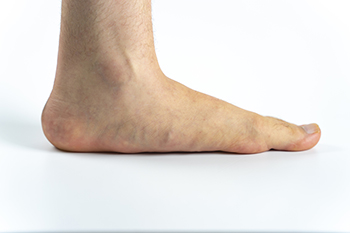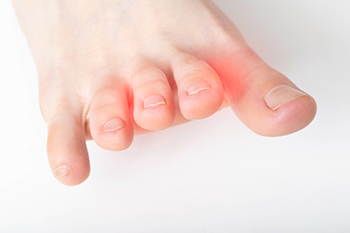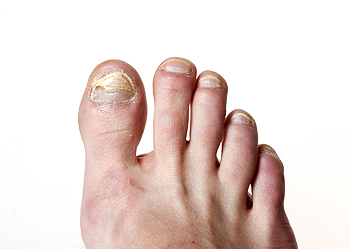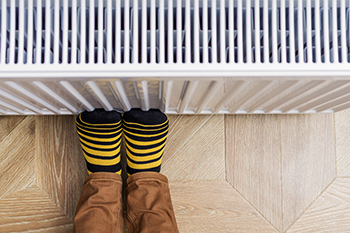Items filtered by date: February 2025
Types and Causes of Flat Feet

Flat feet, or fallen arches, occur when the arches of the feet do not develop properly or collapse over time. Some people are born with flat feet, while others develop it due to factors like aging, injury, or medical conditions that weaken the tendons supporting the arch. There are different types of flat feet, including flexible and rigid flat feet. With flexible flat feet the arch appears when the foot is lifted but flattens when weight is applied. With rigid flat feet the arch remains absent even when the foot is not bearing weight. Some cases of flat feet result from tight Achilles tendons, which affects foot movement. Others stem from problems with the posterior tibial tendon, which runs along the inside of the ankle and supports the arch of the foot. Symptoms may include foot pain, swelling, or discomfort during prolonged standing or activity. A chiropodist can assess the severity of flat feet and recommend treatments, including custom orthotics, exercises to strengthen the foot muscles, and guidance on supportive footwear. If you need help dealing with problems related to flat feet, it is suggested that you schedule an appointment with a chiropodist.
Flat feet are a common foot condition. If you are experiencing pain or discomfort due to flat feet, please consult with one of the chiropodists from Complete Family Footcare & Therapy. Our clinicians will assess your condition and provide you with quality foot and ankle treatment.
What Are Flat Feet?
Flat feet are feet that do not have a well-defined arch in the middle of the sole of the foot. Flat feet may be flexible or rigid. Flexible flat feet have an arch when there is no pressure put on the foot, such as when one is sitting, but the arch disappears upon standing. Rigid flat feet lack an arch regardless of whether one is standing or not.
Causes
Flat feet can be present from birth or acquired over time due to a weakening of the ligaments in the arch. Sometimes flat feet are caused by illnesses, injuries, or pregnancy.
Symptoms
Flat feet often cause no noticeable symptoms. However, some people may experience pain and discomfort due to their flat feet.
Symptoms associated with flat feet include:
Pain in the arch, heel, ankle, or along the outside of the foot
Overpronation of the foot
Shin splints
Aching or fatigue in the feet or legs
Pain in the knees, hips, or lower back
Treatment
In cases where flat feet cause symptoms, there are various treatments available. Wearing orthotic inserts in your shoes to provide more arch support, performing stretches, and taking medications may improve your symptoms. If you are overweight, losing weight can help relieve pressure on the feet. In severe cases, surgery may be considered.
If you have any questions, please feel free to contact our offices located in . We offer the newest diagnostic and treatment technologies for all your foot care needs.
The Impact of Morton’s Neuroma on Daily Life

Morton’s neuroma is more than just foot pain. It is a disruption to daily comfort. This condition, caused by the thickening of nerve tissue between the toes, often feels like a burning sensation, tingling, or the feeling of a pebble stuck in your shoe. Wearing high heels and tight footwear worsen the issue, making each step a painful reminder. Beyond physical discomfort, Morton’s neuroma can limit activity, forcing people to cut back on exercise or even simple walks. Ignoring the symptoms can lead to chronic pain and altered gait, creating additional strain on other joints. Early intervention is key to preventing further nerve damage and keeping you mobile. If foot pain is affecting your routine, it is suggested that you visit a chiropodist for a diagnosis and appropriate care.
Morton's neuroma can be highly uncomfortable. If you are experiencing the symptoms of Morton's neuroma, please consult with one of the chiropodists from Complete Family Footcare & Therapy. Our clinicians will assess your condition and provide you with quality foot and ankle treatment.
What Is a Morton’s Neuroma?
Morton’s neuroma is a condition in which a nerve located in the ball of the foot between the third and fourth toes thickens due to compression or irritation. Common causes of Morton’s neuroma include wearing shoes with high heels or narrow toe boxes, participating in running or court sports, an injury or trauma to the area, or pressure being placed on the nerve from foot deformities such as bunions or hammertoes. Left untreated, Morton's neuroma may result in permanent nerve damage.
Symptoms
Symptoms of Morton’s neuroma often start gradually and worsen over time. Typical symptoms include:
Foot pain
Tingling, burning, or numbness in the affected foot
The unique sensation that something is inside the ball of the foot or that there is something stuck in your shoe while walking
Treatment
Non-surgical treatments for this condition may include padding or icing the affected foot, wearing an orthotic device, modifying activities or shoes to reduce pressure on the foot, and taking medications or getting injections to reduce pain and inflammation. Surgery may be needed if non-surgical treatments are ineffective.
If you have any questions, please feel free to contact our offices located in . We offer the newest diagnostic and treatment technologies for all your foot care needs.
Causes and Treatment of Toenail Fungus

Toenail fungus primarily affects older people, men, and those with underlying conditions like diabetes, poor circulation, or a weakened immune system. This fungal infection, termed onychomycosis, typically develops from dermatophytes, a type of mold that thrives in warm, moist environments like gym locker rooms or shared shower floors. Symptoms of toenail fungus include thickened, discolored, or brittle nails, sometimes with white or yellow patches. In advanced cases, the nails may deform or detach from the nail bed. While toenail fungus is challenging to treat and often recurs, a chiropodist can assist in managing it effectively. This healthcare professional may recommend medical-grade topical treatments and advise on preventative foot care strategies such as keeping nails trimmed, feet dry, and replacing shoes that may harbor fungal spores. If you have developed toenail fungus, it is suggested that you schedule an appointment with a chiropodist.
Toenail fungus can be uncomfortable and unsightly. If you have diabetes or a compromised immune system, it may also be dangerous. To learn more about treatment options, please consult with one of the chiropodists from Complete Family Footcare & Therapy. Our clinicians will assess your condition and provide you with quality foot and ankle treatment.
What Does Toenail Fungus Look Like?
A fungal infection of the toenail may cause the affected nail to become thickened, brittle, crumbly, and yellowish or brown in color. Sometimes the toenail may separate from the nail bed, become deformed, emit a foul odor, or cause pain or discomfort.
What Causes Toenail Fungus?
Toenail fungus is caused by a fungus that infects the nail bed. The fungus lives and thrives in warm and moist environments and is also contagious. Athlete’s foot, which is a fungal infection of the skin, may spread to the nails and cause toenail fungus.
What Treatments Are Available?
Potential treatments for toenail fungus may include oral antifungal medications, topical antifungal medications, such as medicated nail polishes that are applied directly to the affected nail, and laser therapy. Sometimes, a combination of treatments is prescribed.
If you have any questions, please feel free to contact our offices located in . We offer the newest diagnostic and treatment technologies for all your foot care needs.
Tips for Keeping Your Feet Warm During Winter

During the winter keeping your feet warm is essential for comfort and health. Start the day with warmth by wearing socks and shoes that provide insulation, ensuring your feet stay cozy as you begin your activities. Choose thick, thermal socks made of wool or moisture-wicking materials that trap heat while allowing your feet to breathe. When selecting boots, ensure they are the right size for the number of socks you plan to wear. Boots that are too tight can restrict blood flow, while boots that are too loose may fail to keep warmth inside. Additionally, consider insulating the ground beneath your feet by wearing insoles with extra padding or using thermal mats when standing for extended periods. These steps will help prevent cold feet and improve circulation, ensuring your feet stay warm and comfortable throughout winter. If you have developed foot pain, it is suggested that you consult a chiropodist who can treat various foot conditions and educate you on effective methods for keeping your feet warm during the cold months.
The winter months can bring about new or worsening foot and ankle problems. If you’re suffering from foot or ankle pain, please consult with one of the chiropodists from Complete Family Footcare & Therapy. Our clinicians can help you maintain the health of your lower limbs and your mobility.
Winter Foot Problems
Cracked heels - Dry, cracked skin on the heels of the feet that is associated with cold, dry weather
Athlete’s foot - A fungal infection on the skin of the feet
Blisters - Fluid-filled bubbles of skin that usually form in response to friction
Fractures - Broken bones in the feet or ankles
Metatarsalgia - General foot pain
Chilblains - Spasming of the small blood vessels in the toes in response to exposure to cold weather
Raynaud’s disease - Numbness, pain, and color changes in the toes due to cold weather
Prevention
Wear warm socks and shoes
Avoid prolonged exposure to the cold
Moisturize the heels regularly
Keep your feet clean and dry
Walk carefully in areas that may be icy
Wear non-slip shoes
If you have any questions, please feel free to contact our offices located in . We offer the newest diagnostic and treatment technologies for all your foot care needs.
